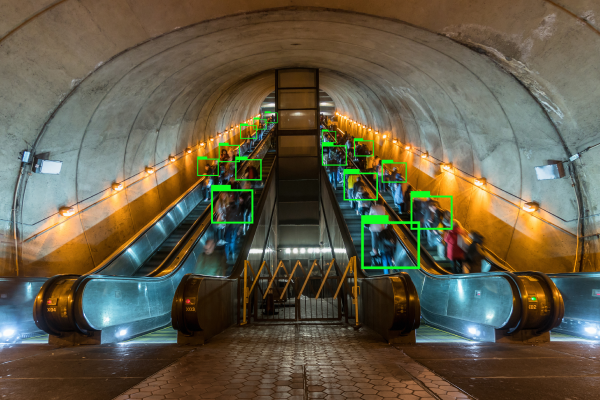Top Use Cases of AI/ML Based Object Recognition
by Smitesh Singh, on Nov 9, 2021 11:06:06 PM
Image recognition without human intervention was once deemed unimaginable. However, as technology began unwinding, AI/ML based machine manipulation, and so to recognize objects without any human meddling became one of the most promising technologies of today and tomorrow. Today almost every commercial enterprise is employing object recognition, and the ones that are not, are facing the repercussions of high operational costs, mediocre CX, and human errors in their critical business environment. In this blog we will talk about some prominent use cases of mobile app based object recognition that are changing the whole ball game for commercial enterprises.

Let’s focus on the real-life applications that are powered by these technologies.
1. Monitoring Visual Listing
Brands often need to monitor their presence across social media, in terms of mentions, and tags to understand how the audiences perceive a brand with the help of object recognition tools. The image recognition technology helps brands achieve visual or social listening by comparing respective objects in a picture posted over social media with a gamut of predefined objects, entities, and images and data about them. The proprietary brand app can be incorporated with object recognition algorithms along with social media APIs that can keep track of a user’s face, objects, brand logos, and negative feedback. This data can directly help in quantifying the brand affinity and tweaking strategies to enhance it.
2. Medical Image Analysis
Healthtech solutions powered by AI/ML based object recognition can help radiologists reduce their workloads by monitoring scans and medical images such as ultrasounds, CT scans, x-rays, MRIs etc. Algorithms can detect acute deviations, patients at risk and the ones needing urgent treatment. It can help radiologists prioritize their workload. For example, IBM’s research branch in Israel, and Haifa, is creating an AI/ML-based solution called -Cognitive Radiology Assistant, that offers support to radiologists, by analysis of medical images and insights from patient medical record.
3. Self-driving cars
Object recognition is one of the key technologies in self-driving cars. These systems need to be able to identify, locate, and track objects around them in order to move through the world safely and efficiently. And while tasks like image segmentation can be and are often applied to autonomous vehicles, object detection remains a foundational element in a vehicle linked handheld device that can work as a central controller for self-driving cars.
4. Image Recognition for Artpieces
A number of art galleries are using object detection through machine learning algorithms. There are mobile apps that enable users to click images of the art. Using these images, the app offers users with details like the creator of the art, name and year of birth, physical dimensions, description, material and more importantly, the current price and historical price. Smartify is one such app, which helps the museumgoers’ in gaining maximum information. The app makes use of image recognition to verify the viewed artworks with the vast digital databases of 50,000 art pieces in the year 2017.
5. Animal Detection and Measurement
Camera sensors that sense motions are actively used in forests to capture humungous data about animals. However, manual image analysis becomes an obstacle in channeling the complete potential of this collected data. Organizations are vigorously working over developing feature detection solution based on machine learning. This technology can automate animal identification at 96.6% accuracy, thereby helping in reduction of mishaps, and activities like poaching. The automation of data collection process is going to help a number of fields including wildlife, zoology, biology, conservation biology, hunting etc.
6. Facial Recognition at airport check-ins
Airlines have begun using facial recognition to improve check-in as well as boarding experience for the customers. Adoption of AI in airports is being encouraged to promote self-service, and make the experience at airports faster and secure. Airlines can also achieve better cost efficiencies, as they need minimal staff communication with the customers. The boarding equipment based on facial recognition scans passenger faces and compares them with the photos in the database of border controlling agency to verify identity of the passengers and flight details. The database can have information in the form of national IDs, visas, and other documents.
7. Visual Product Search
Having a seamless customers experience is the key, more so as boundaries of offline and digital shopping have started shrinking. As retailers adopt visual search, Google Lens is becoming mainstream for product lookup. Features like Scan and Shop in a digital marketplace app, can help customers look for the exact product at best prices. Sometimes, customers look at a product and wish to buy it instantly or at a later time, but it becomes a hassle for them to find the name of the product or its details. Object detection with machine learning takes care of this issue and lets customers scan the product they have found in a magazine, physical store, or with someone. A quick scan can provide them detailed information on the work they wish to buy online.
8. Managing SKUs in stores and warehouses
While users buy from supermarkets, they make final buying decisions over the shelves. The companies specializing in consumer packaged goods invest in techniques to develop planograms which are inevitable to an ideal strategy for store management. Monitoring shelf state with the object detection and machine learning fosters store intelligence, and allows managers to improve shelf planning.
Wrapping Up
The need for object detection using machine learning is soaring everyday. Companies are already investing millions of dollars to achieve maximum efficiency. In order to discuss and implement your industry relevant use cases of image recognition technology, get in touch with an AI/ML app development services company.
Next Reading:
- How Health Insurance Apps Are Changing The Industry Landscape for Health and Finance
- AI/ML, Big Data and Mobility Use Cases for Fintechs and Banks
- How to Build a Reliable Waste Management and Segregation App

















